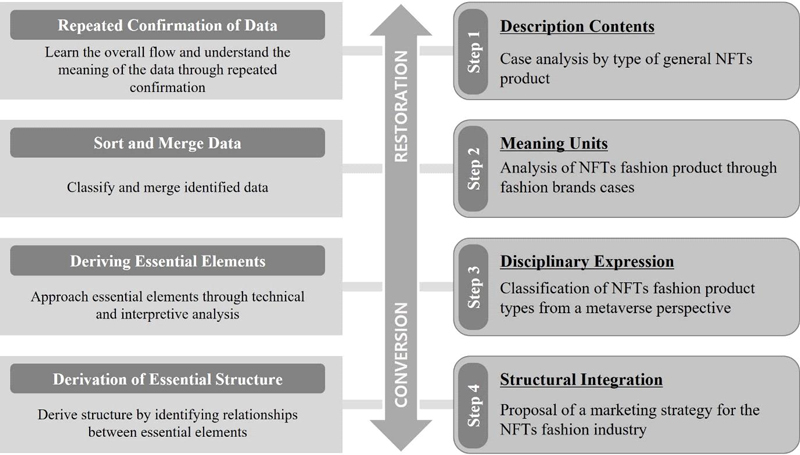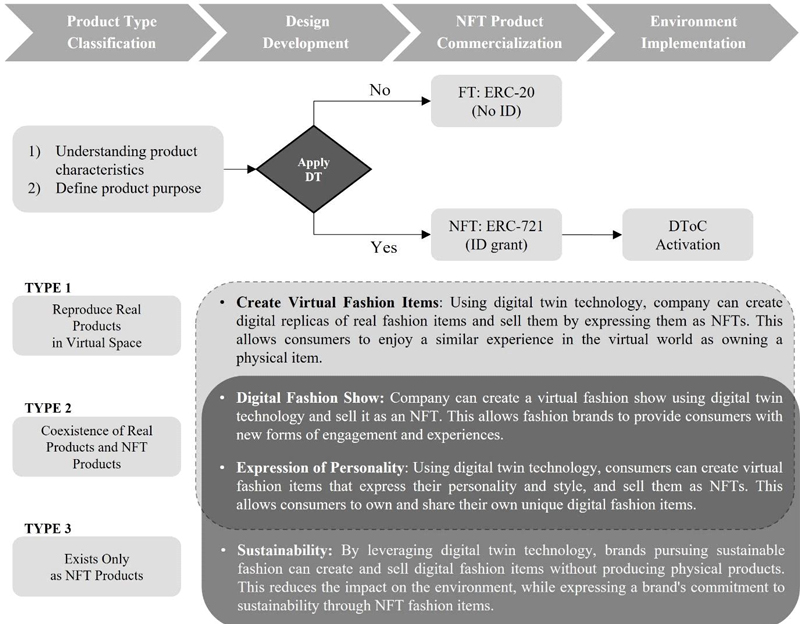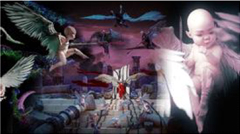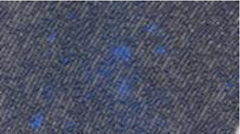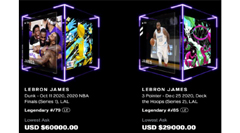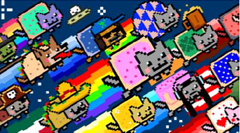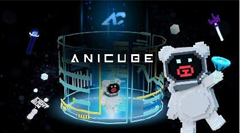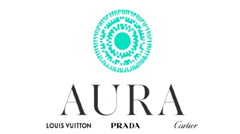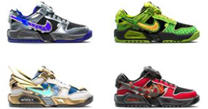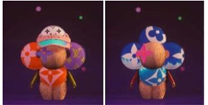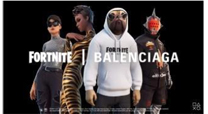
NFTs(Non-Fungible Tokens) 패션상품 유형 분석을 통한 NFTs 패션 마케팅 전략 방향성 탐색
Abstract
The rapid advancement of Web 3.0 is accelerating the development of NFT and blockchain technologies, substantially improving consumers' digital activities and experiences. The rapid growth of the NFT market highlights the growing importance of digitalization, particularly in the fashion industry, which is expected to be restructured and commercialized in this new environment. NFTs guarantee originality, uniqueness, and scarcity, adding value to digital works through media data, smart contracts, and metadata. The continuous growth of art-related NFTs underscores the potential for issuing and expanding fashion product NFTs. This study analyzes data from recent NFT-related papers, domestic and international literature, and reports from various research institutes. The findings were reinterpreted to provide insights applicable to fashion-related studies and the fashion industry. While fashion product NFTs and the development of suitable platforms for their trading can be viewed as extensions of the existing NFT industry, the unique characteristics of the fashion industry must be considered. It is essential to incorporate additional factors into fashion NFTs beyond the inherent qualities of originality, uniqueness, and scarcity associated with existing NFTs. Doing so can establish a marketing environment based on consumer experience and perceived value.
Keywords:
digital twin, fashion marketing strategy, NFTs fashion product, phenomenological qualitative research, Web 3.0키워드:
디지털 트윈, 패션 마케팅 전략, NFTs 패션상품, 현상학적 질적연구, 웹3.0Ⅰ. 서론
메타버스 생태계는 플랫폼, 콘텐츠, 지적재산권과 데이터나 네트워크 등의 인프라로 구분된다(Bae, 2023). 일종의 인프라로 간주할 수 있는 Web 3.0에서의 블록체인 기술을 기반으로 현실과 가상세계를 넘나드는 새로운 경제 체계인 NFTs(Non-Fungible Tokens)는 ‘대체불가능한 토큰’으로 정의된다. NFTs는 블록체인(Blockchain)내에서 가치를 갖는 모든 디지털 물체가 가상공간에서 저장 및 유통이 가능하게 해주는 일종의 디지털 파일로(Bamakan, Nezhadsistani, Bodaghi, & Qu, 2022), NFTs는 가치에 영향을 미치는 그 자체의 고유한 정체성을 내포하고 있다(Dowling, 2022). 개인 컴퓨터를 통해 단순 읽기 기능만을 제공했던 Web 1.0과 거대 플랫폼을 중심으로 읽기 및 쓰기 기능을 제공한 Web 2.0의 모바일 및 클라우드 인프라에 ‘소유’의 개념이 추가된 Web 3.0은 자체적으로 실행할 수 있도록 지능화됨과 동시에 개인화된 맞춤형 웹 방식의 네트워크라는 의미가 내포되어 있다(Stackpole, 2022). Web 3.0으로의 혁신은 메타버스(Metaverse)와 블록체인을 바탕으로 탈중앙화 금융인 디파이(Defi, Decentralized Finance)시스템이 도입되어 가상세계에서의 NFTs를 실현했다(W. Park, 2022). Web 4.0에 대한 명확한 정의는 아직 확립되지 않았지만 일반적으로 Web 4.0은 ‘초연결 웹’이라고 불리며, 모든 사람과 장치가 실시간으로 연결되어 있는 상태를 의미한다. 이는 사물인터넷(IoT, Internet of Things)과 인공지능(AI, Artificial Intelligence) 기술이 빅데이터(Big Data) 등의 기술과 함께 본격적으로 활용되는 시대를 상징한다고 볼 수 있다. 따라서 Web의 발전 단계별 특징은 <Table 1>과 같이 구분된다.
현재 NFTs 시장은 Web 3.0 환경에 놓여 있으며(Raj, 2022) 블록체인 기술을 기반으로 하는 NFTs는 Web 3.0의 핵심 요소 중 하나이다(Kim, 2023). 이러한 NFTs는 블록체인 기술을 통해 디지털 자산의 소유권을 명확하게 할 수 있으며, Web 3.0의 주요 목표인 '데이터 소유를 개인화’하는 측면을 반영하므로(Y. Ha, 2022) 현재 NFTs 시장은 Web 3.0 환경, 즉 '분산형 인터넷 시대’의 시작을 주도하고 있다고 볼 수 있다.
이처럼 현재 NFTs 거래의 활성화는 블록체인 내에서 다오(DAO, Decentralized Autonomous Organization)를 기반으로 소비자들의 움직임이 활발해졌기 때문인데, 다오란 Web 3.0 환경 내에서의 ‘탈중앙화 자율 조직’을 의미한다(O. Ha, 2022). 그동안 우리에게 익숙했던 디지털 기술은 다수의 복사본을 쉽게 공급할 수 있다는 ‘카피 앤 페이스트(Copy and Paste)’가 장점이었으나 동일한 디지털 환경 내에서 발전을 거듭한 NFTs는 이와 정반대를 추구한다. 블록체인 위에 오직 한 개만 존재하도록 만든 디지털 토큰인 NFTs는 <Fig. 1>에서 보이듯이 동일한 그림이라도 일종의 ID번호가 부여되어 ‘독자성’이 유지된다. 이러한 ‘희소성’이 바로 NFTs 상품의 가치를 끌어올리는 중요 요소이며(Franceschet et al., 2021), 소비자들이 다오와 디파이를 통해 NFTs를 소비하는 이유이기도 하다. 이러한 디지털 시장의 성장은 NFTs 시장의 급성장을 주도하여 다양한 산업군으로 확대되고 있다(Wilson, Karg, & Ghaderi, 2021).
Statista에 따르면 2021년 글로벌 NFTs 시장 규모는 약 400억 달러에 달하였으나(Buchholz, 2022) 2023년 글로벌 NFT 시장 규모는 약 269억 달러로 추정되었다(Grand View Research, n.d.). NFTs 연구회사 NFT Plaza는 NFTs 시장이 급격히 성장하던 초기보다 그 규모가 다소 감소되어 2023년 NFTs 시장의 거래량은 약 100억 달러로 62% 감소했지만, 활성화된 지갑은 10%만 감소하였기 때문에 이를 회복의 징후로 분석하였으며(Leah, 2024) Cointelegraph는 NFTs 총 판매량을 카테고리별로 분류한 결과, 수집품과 미술품이 전체의 91%를 차지했다고 밝혔다. 패션산업에서 NFTs 상품 및 플랫폼 개발이 매우 활발한데 특히 명품 NFTs 시장 규모는 2030년까지 약 5백 60억 달러(66조 8천억 원)에 이를 것으로 전망되었다(Buchholz, 2022).
NFTs 관련 산업들의 발전과 높은 관심으로 최근 다양한 분야의 연구들이 국내외에서 매우 활발히 진행되고 있다. 그중 국내 연구를 살펴보면, NFTs 미술시장에 관한 연구에서는 기존 미술시장과 다른 특성과 전망 등을 다루었으며(Kim & Yong, 2021), NFTs 플랫폼 자체를 분석하여 해당 플랫폼을 이용하는 목적을 통해 상품에 대한 가치를 논의하거나(Kim & Lee, 2021; Park, Park, Kim, & Song, 2018) 융복합예술 측면에서 NFTs 디지털 작품에 대한 인식 현황을 연구하였다(J. A. Park, 2022). 패션 분야에서는 메타버스를 활용한 명품브랜드의 마케팅 사례를 분석하거나(Kim & Lee, 2022) 지속가능한 가치 측면에서 NFTs 패션을 다룬 사례연구(Lee & Lee, 2022), 그리고 NFTs 패션상품을 유형화하여 그 가치를 탐구한 연구(Yoo & Choi, 2022) 등이 발표되었다. 그러나 발표된 연구의 수 자체가 아직 미미한 수준이며, 해당 기술을 활용한 산업의 급속한 진화로 인해 메타버스의 현재 범위와 그에 따른 마케팅 전략 및 연구의 방향성에 대한 명확한 이해는 여전히 부족한 실정이다(Barrera & Shah, 2023).
NFTs 시장의 지속적인 성장은 NFT의 독특한 특성과 블록체인 기술의 발전, 그리고 디지털 자산에 대한 투자자들의 관심 증가 등 다양한 요인에 기인하고 있다(De Felice, De Luca, Di Chiara, & Petrillo, 2023). 모든 산업과 상품은 결국 소비자의 역할이 매우 중요하며(J. A. Park, 2022) 패션산업 역시 NFTs와 함께 성장하기 위한 노력에 박차를 가하고 있으므로(Kim & Lee, 2022) NFTs 패션에 관한 연구 역시 함께 진행되어 NFTs 패션상품에 대한 소비자 측면 역시 학술연구를 통해 심층적으로 다루어져야 할 것이다. 따라서 본 연구는 패션산업에서 NFTs 상품 개발 및 유통시스템에 적용할 수 있는 가이드라인을 제공하기 위한 기초연구로 소비자들의 NFTs 패션상품에 대한 가치 확립을 NFTs 패션상품의 특성을 통해 달성하는데 그 목적이 있으며 이를 위해 현상학적 측면에서 NFTs 패션상품의 유형을 분류하고 각각의 유형을 대입할 수 있는 마케팅 전략을 제안해보고자 한다.
Ⅱ. 본론
1. 디지털 자산 유형과 NFTs
NFTs 상품을 이해하기 위해서는 우선 디지털 자산(Digital Asset)의 유형에 대한 이해가 필요하다. 전자적인 형태로 존재하는 가치를 갖는 자산을 의미하는 디지털 자산은 디지털 형식으로만 존재하며(Lim, 2023) 뚜렷한 사용 권한 또는 사용 권한이 부여되는 모든 것을 포함한다(Hwang, 2021). 이러한 자산은 기존의 물질적인 형태의 자산과 달리 디지털 형태로만 존재하며, 주로 컴퓨터나 인터넷 등 디지털기기를 통해 전송되고 저장되므로(Lim, 2023) 디지털 자산에는 현재 유통 중이거나 개인용 컴퓨터, 노트북, 휴대용 미디어 플레이어, 태블릿, 데이터 저장 장치, 통신 장치 및 디지털 자산을 운반할 수 있는 새로운 형식의 개념을 수용하기 위해 기술이 발전하면 존재하거나 존재하게 될 모든 장치를 통칭한다고 볼 수 있다. 디지털 자산의 유형은 <Table 2>와 같다.
이러한 디지털 자산이 많이 활용되는 방식 중 하나가 바로 NFTs이다(Lim, 2023). NFTs가 많은 산업에 소개된 후 다양한 형태의 디지털 상품을 거래하는 플랫폼이 급격히 증가하였다(Martinod et al., 2021). 이는 가상과 현실이 융합된 디지털 상품 소비로 소비자들의 행동에 전환이 일어나고 있음을 시사하는데 이러한 트렌드는 국내외 다양한 산업 분야 뿐 아니라 학계에서도 주목하고 있다. 따라서 본 연구는 현상학적 관점에서 NFTs 상품의 사례를 파악하고 이를 매트릭스 분석방법으로 해석하여 NFTs 패션산업의 마케팅 전략 및 방향성을 제안해보고자 하였다.
2. 현상학적 방법론의 활용
현상학적 연구는 해석학적 순환을 통해 우리가 탐구하고자 하는 대상의 존재 의미를 확인해볼 수 있는 방법론 중 하나로(Heidegger, 1927/2010), Edmund Husserl이 초기 주창한 현상학은 인간의 의식에 나타나는 현상을 그 자체로 기술하기 위한 방법을 위한 것이었다(Stevenson & Haberman, 1974/2006). 이는 어떠한 사물이나 현상이든 인간의 직관을 통해 분석할 수 있다고 주장하는 방법론으로 인간의 경험, 특히 체험을 연구하기 위한 연구방법으로 많이 활용된다(van Manen, 2014). 그러나 연구 대상을 특정 사례나 특정 문화로 할 경우에도 충분히 다양한 유형의 현상학적 방법으로 접근하고 이를 탐구하는 것이 가능하므로(Lee, 2014) 본 연구에서는 Giorgi와 Van Kaam의 현상학적 연구 방법론을 바탕으로 한 Galinha-de-Sá & Velez(2022), Kim et al.(1999)과 Rahilly(1993)의 연구방법을 본 연구 목적에 맞도록 NFTs 상품을 하나의 개체이자 현상으로 간주하여 해당 상품이 활용되는 산업 환경을 분석하였다. 또한, NFTs 패션상품에 내제된 본질적 의미를 탐색하고 이를 수용하는 세대의 문화 변화에 맞는 적합한 마케팅 방안을 단계별로 도출하는 방식으로 진행하였다. 본 연구분석의 단계적 절차는 <Fig. 2>와 같다.
총 네 단계에 걸쳐 진행한 분석 단계는 순서대로 다음과 같다. 1단계는 현상학적 태도와 전체적인 감각을 얻기 위해 전체 범주 안에서 해당 주제의 문맥을 통해 구체적인 기술 내용(Description Contents)을 확인하는 단계를 진행한다. 이는 전체 내용을 인식하여 큰 그림을 그려 의미를 파악하는 단계로 볼 수 있다. 이를 위해 다양한 NFTs 사례에 대한 전반적인 내용을 순서대로 확인한 후 다시 처음의 사례로 돌아가 재확인하는 과정을 반복하였다. 2단계에서는 해당 내용에서 발견된 기본 의미를 단위형태(Meaning Units)로 구분 및 결정하는 단계이다. 1단계에서 인식한 전체적인 내용을 바탕으로 주제화를 시켜 특정 사례별로 구분 지을 수 있는 단계로, 본 연구에서는 NFTs 사례들을 상품 특성별로 구분한 후 NFTs 패션상품의 사례를 선별하고 이를 유형별로 다시 분류하여 해당 특성을 구체적으로 살펴보았다. 3단계는 1단계와 2단계 과정을 통해 분류 및 도출된 내용의 명제화를 위해 학문적 표현(Disciplinary Expression)으로 적합하게 변형시키는 단계이다. 여기에서는 앞서 분류된 NFTs 패션상품의 특성을 학문적 관점에서 통찰하여 이를 NFTs 패션상품 유형별로 변형하였다. 마지막 4단계에서는 최종적인 모델을 위해 3단계에서 도출 및 설정된 내용의 수준을 구조적으로 통합(Structural Integration)하는 단계이다. 해당 단계에서는 NFTs 패션상품 유형별로 도출된 특성을 바탕으로 마케팅 전략을 분류한 후 이를 활용할 수 있는 방안을 다시 통합시키는 과정을 거쳐 최종적인 마케팅 활용 방안을 제시하였다.
3. NFT 상품의 유형별 사례분석
NFTs 산업이 소개되던 초기만해도 대체적으로 NFTs 상품이 활용되는 목적에 따라 미술품(Art), 수집품(Collectibles), 게임(Gaming), 엔터테인먼트(Entertainment), 유틸리티(Utilities) 등으로 나뉘었으며 NFTs 발행과 거래를 전문으로 하는 플랫폼들 역시 일종의 산업군으로 분류하였다. 연구방법의 1단계에서 NFTs 관련 전체 사례를 바탕으로 전반적인 NFTs 상품군을 구분하는 과정을 통해 도출된 대표 사례를 바탕으로 구성한 <Table 3>에서 보여지는 바와 같이 최근에는 NFTs 기술을 통해 구현할 수 있는 특성이 내제된 상품이 개발되어 NFTs 산업군이 점차 확장되고 있으며, 기존 상품의 활용 목적과 그에 따른 상품 유형이 하나에 얽매이지 않고 여러 특성이 복합된 형태로 진화되고 있다. 이는 디지털 산업에서의 문화예술콘텐츠는 디지털 자산 소유권을 증명하는 기술인 NFTs와 연계될 수밖에 없는 환경임을 주장한 Hong(2022)의 의견과 동일한 맥락에서 현재의 NFTs 시장 상황을 재확인할 수 있는 결과이다.
4. 패션 브랜드의 NFTs 사례를 통한 패션상품 유형 분석
1단계에서 분류한 NFTs 전체 상품군에서 단위 형태로의 세분화를 위해 2단계에서는 특정 영역인 패션산업에서의 NFTs 상품 유형을 판별하기 위해 메타버스에서 소비자에게 NFTs 상품을 제공하고 있는 패션브랜드 중 활발한 행보를 보이는 대표사례를 바탕으로 <Table 4>와 같이 구성하였다. 현재 생산, 배포 및 판매되고 있는 NFTs 패션상품은 기본적으로 우리가 쉽게 떠올릴 수 있는 아바타 아이템과 같은 메타버스에서 사용할 수 있는 제품군과 메타버스를 기반으로 디지털 환경에 맞춰 특별히 생산된 제품군으로 분류되었다. 이를 통해 각 제품군에 내재된 특성은 다르지만 현재에는 메타버스와 연관된 모든 제품이 NFTs 상품이라 통용되어 불리고 있음을 알 수 있었으며 NFTs 패션상품은 그 자체가 매우 광범위하고 다양한 산업과 연계되어 있음을 확인하였다(Lee & Lee, 2022).
3단계에서는 NFTs 패션상품에 대한 심층적인 이해를 위해 패션상품 자체를 범주화하여 그 특성 및 가치를 분석하고 패션상품의 고유 인식과 NFTs 상품으로의 변화 과정을 확인 후 유형별 분류작업을 진행하였다. 이를 기반으로 3가지 유형의 NFTs 패션상품이 도출되어 <Fig. 3>과 같이 현실세계와 연계된 메타버스의 관점에서 분석하였다.

Classification of Types of NFTs Fashion Products from a Metaverse Perspective linked to the Real World
유형 1의 경우는 현실에 이미 존재하는 상품을 단순히 가상 공간에서 소개하기 위해 재현된 상품으로, 소비자가 실제 매장에서 만날 수 있는 제품 그대로 디지털화 하여 메타버스 컬렉션에서 공개한 제품을 의미한다. 다수의 럭셔리 브랜드들이 디지털 패션쇼에서 선보인 컬렉션을 그 예로 볼 수 있다. 해당 유형의 상품 구매는 불가능하며 실제 제품만을 구입할 수 있다.
유형 2의 경우는 현실과 가상 공간에 모두 존재하는 제품을 의미한다. 예를 들어, 나이키의 스니커즈 제품을 로블록스(Roblox)에서 NFTs 아이템으로도 구매할 수 있거나 구찌의 컬렉션 일부 제품을 제페토(Zepeto)의 아바타 아이템으로도 만나볼 수 있는 경우가 그 사례이다. 그러나 유형2에는 선후관계에 따라 상품군이 구분될 수 있다. 보통 실제 상품을 디지털 상품화하여 메타버스 상에서도 동일한 NFTs 상품을 구매할 수 있도록 서비스하지만, 발렌시아가와 포트나이트(Fortnite)의 협업으로 생산된 NFTs 상품은 게임내에서 구매할 수 있는 아이템으로 먼저 공개된 후 이를 실제 상품으로도 생산하여 소비자들에게 판매되었다. 이처럼 실제 현실에서 선공개 된 상품을 추후 NFT 상품으로 공개하거나, 메타버스 안에서 먼저 선공개 하여 판매되고 있는 NFTs 상품을 실제상품으로도 제공하는 경우로 구분해볼 수 있다.
유형3의 경우는 오직 가상세계에만 존재하는 NFTs 상품으로 실제 실물상품으로는 만나볼 수 없고 메타버스 플랫폼 내에서만 구매 및 이용이 가능한 상품이다. 이는 대부분이 각 패션브랜드들이 연계한 메타버스 플랫폼 내에서만 확인이 가능한 상품들로 수집 또는 소장품으로 이루어졌거나 아바타 활동에 필요한 아이템들로 구성되었다.
5. 디지털 트윈(Digital Twin)을 활용한 NFTs 패션상품의 마케팅 전략
메타버스의 NFTs 기술의 이점은 개인에게 자신의 ID와 데이터에 대한 더 많은 통제권을 제공하고 경험 범위를 디지털 통화와 통합할 수 있는 가상 장소 및 생태계로의 확장이 가능하다는 것이다(Min, Kim, & Park, 2021). 이를 통해 소비자에게 새로운 인식을 강화하거나 보상을 창출할 수 있는 새로운 방법을 제공할 수 있으므로 4단계에서는 3단계인 <Fig. 3>에서 도출된 NFTs 상품유형을 구조적으로 통합한 후 이를 단계별로 구분하여 최종적으로 마케팅 전략과 활용방안을 구축하였다. <Fig. 4>에서 제시하는 전략은 바로 디지털 트윈(DT, Digital Twin)의 활용이다.
디지털 트윈(DT)은 현실 세계에 존재하는 사물, 성질, 환경 등을 가상공간에 동일하게 구현하는 기술을 의미하는데(Wang, Chen, Jia, & Cheng, 2023), 이때 DToC(Digital Twin of the Customer)는 소비자의 동작을 모방하고 예측하여 이를 시뮬레이션하고 학습하는 일종의 동적 가상 표현을 의미한다(Schroeder, 2022). <Fig. 2>에서 확인된 바와 같이, 기존 NFTs 패션상품은 그 자체 특성상 실제 세상 즉, ‘Real World’에서는 소유권만 존재하며 ‘Metaverse’에서만 그 가치를 실현할 수 있었으나, 현재 소비자에게 제공되는 NFTs 패션상품은 실제와 가상의 구분 없이 그 가치를 실현할 수 있어 기존의 상품이 갖는 특성과는 다소 다르다. 따라서 <Fig. 3>에서 도출된 NFTs 패션상품 유형별로 적합한 디지털 트윈 기술을 <Fig. 4>와 같이 활용하여 NFTs 패션상품의 마케팅 전략을 구성하였다.
디지털 트윈은 실제 세계의 물리적 객체를 디지털로 복제하는 기술이므로(Wang et al., 2023) 이를 NFTs 패션상품에 활용하는 것은 새로운 가능성을 열 수 있다. 우선 디지털 트윈 기술을 사용하여 실제 패션상품의 디지털 복제본을 만들고 이를 NFTs로 상품화하면 소비자는 실제 상품을 소유하는 것과 유사한 경험을 가상 세계에서 누릴 수 있을 뿐만 아니라 디지털 패션쇼를 통해 디지털 트윈 기술을 활용하여 가상 패션쇼를 제작하고 NFTs 판매를 통해 패션 브랜드는 소비자에게 새로운 형태의 참여와 경험을 제공할 수 있을 것이다. 또한 디지털 트윈 기술을 활용하여 소비자는 자신의 개성과 스타일을 표현하는 가상 패션 아이템을 제작하여 이를 NFTs로 판매하고 실제 상품으로의 역생산을 통해 소비자는 자신만의 고유한 디지털 패션상품을 실제로도 소유하고 가상으로도 공유할 수 있게 된다. 마지막으로 지속 가능한 패션 관점에서 디지털 트윈 기술을 활용하면 지속가능한 패션을 추구하는 브랜드는 실제 제품을 생산하지 않고도 디지털 패션 아이템을 만들고 판매할 수 있다. 이는 환경에 미치는 영향을 줄이는 동시에 NFTs 패션상품이 지속가능성에 대한 브랜드의 신념을 소비자에게 표현할 수 있는 환경을 제공해 줄 것이다. 이처럼 NFTs 패션상품 유형별로 각각 다른 방식으로의 디지털 트윈을 활용하면 기존의 고객 경험을 보완하고 이를 좀 더 향상시키는데 필요한 새로운 디지털화 기능, 제품, 서비스 개발에 활용이 가능하다.
Ⅲ. 결론
디지털 기술 발전과 산업구조 변화에서 기인한 유통 플랫폼의 진화는 수익모델의 변화를 초래하며(Barrera & Shah, 2023) 이에 따라 판매 상품의 유형 및 특성에 따른 유통과 판매에 대한 비즈니스 모델 개발은 소비자들의 구매행동 패턴을 관찰하고 소비심리 변화를 심층적으로 이해하는 것을 바탕으로 실행되어야 한다. 또한, 디지털 콘텐츠 기반의 e-커머스 시장의 발전 속에서 NFTs 상품의 유형별 소비자들의 인식 차이를 살펴보고 이를 체계적으로 분석하여 리테일 미디어를 활용할 주력 NFTs 패션상품군을 범주화하는 방안이 제시되어야 한다. 이는 국내외 판매 채널의 구조 및 판매 상품 분석을 통한 NFT 상품 제안에는 광범위한 자료수집과 분석 뿐 아니라 학문적 연구를 기반으로 이론적 근거를 통해 수행되어야 한다(De Felice et al., 2023). 따라서 본 연구에서는 현상학적 관점에서 단계별로 분석된 결과를 바탕으로 디지털 트윈기술이 패션 산업에서 제품 개발부터 마케팅, 고객 경험 제공 및 지속가능성 추구에 이르기까지 다양한 분야에서 활용될 수 있음을 확인하였다.
본 연구에서 제시한 NFTs 패션상품에 디지털 트윈을 도입하여 이를 패션마케팅 전략으로 활용하는 방안은 다음과 같이 요약해볼 수 있다. 첫째, NFTs 패션상품의 유형별로 제품 개발과 디자인에 디지털 트윈을 활용한다. 이는 실제 제품의 디자인, 품질, 스타일 및 기능을 시뮬레이션하고 테스트할 수 있으므로, 생성된 NFTs 패션상품은 소비자의 욕구와 선호도를 반영하고 경쟁력을 갖추게 될 것이며 디지털 트윈의 활용 과정에서 발생하는 소비자 경험은 소비자가 제품을 가상으로 체험하게 하여 더 높은 수준의 서비스와 만족도를 제공하게 되어 긍정적인 소비자 경험을 이끌어낼 수 있을 것이다. 둘째, 마케팅 커뮤니케이션에 디지털 트윈을 활용하여 NFTs 패션상품을 소비자에게 소개하고 브랜드를 홍보할 수 있다. 이는 메타버스 패션쇼나 가상 피팅룸 등을 통해 소비자에게 새로운 쇼핑 경험을 제공할 수 있다. 셋째, 고객 데이터 분석에 디지털 트윈을 활용한다. 디지털 트윈을 통해 수집된 고객 데이터를 분석하여 고객의 선호도나 구매 패턴 등을 파악하고, 이를 바탕으로 맞춤형 마케팅 전략을 추가적으로 수립할 수 있을 것이다. 넷째, 지속가능성과 윤리적 관점에서 디지털 트윈 기술을 활용한다. 이는 지속가능한 패션과 윤리적 생산 및 소비에 대한 소비자의 관심을 높일 수 있게 될 것이다. 이처럼 NFTs 패션상품에의 디지털 트윈 활용은 더욱 효과적인 제품 개발과 마케팅 전략을 수립할 뿐만 아니라 소비자에게 새로운 쇼핑 경험을 제공할 수 있을 것이다.
본 연구의 학문적 시사점은 다음과 같다. 본 연구는 NFTs 관련 산업의 다양한 사례를 분석하는 과정에 현상학적 질적연구 방법론을 접목하였다. 이는 일반적인 사례분석에서 그치지 않고 더 나아가 심층적인 이론 활용을 통해 합리적 근거를 제시하고 이를 활용할 수 있는 접근을 시도하였다는데 학문적으로 시사하는 바가 크다. 이를 통해 다양한 연구와의 이론 접목 및 심층적 논의가 가능하며 후속 연구에 필요한 합리적 근거를 학문적 측면에서 제시하였다는데 본 연구의 의의가 있다고 사료된다. 또한, NFTs 시장의 잠재력은 실질적으로 무한하며 향후 NFTs와 블록체인 기술이 다양한 산업에서 긍정적 또는 부정적 상황에 직면할 가능성이 예상되는 바, 앞으로 다양한 학문 분야에서 연구에서 선두적으로 의류학 분야의 기초 연구를 주도하여 후발 학술연구의 선행연구로 본 연구가 활용될 수 있다는 점에서 학문적으로 시사하는 바가 크다고 여겨진다.
실무적 시사점으로는 NFTs 상품판매 및 유통에 필요한 기본정보를 마케팅적 관점에서 제공하였다는데 그 의의가 있다고 하겠다. NFTs 산업은 시작 단계를 거쳐 확산기에 접어들고 있으며 전 산업에서 NFTs 시장에 진출하고 있으나 아직은 해당 산업이 나아가야 할 방향성 및 산업 내 긍정/부정적인 측면을 판단하기 어려운 실정이다(De Felice et al., 2023). 따라서 NFTs와 접목된 다양한 산업 생태계와 비즈니스 모델에 대한 충분한 이해가 기업과 소비자들 모두에게 중요한 시점이다. 본 연구의 분석결과를 통해 도출된 NFTs 패션상품 유형별 특성 및 소비자와의 직/간접적인 영향 관계에 대한 구조적 모델 분석은 NFTs 산업에 필요한 기본정보로 활용할 뿐만 아니라 해당 산업에 활용할 수 있는 비즈니스 모델을 구축하는데 필요한 필수 정보로 2차 활용하여 주력 NFTs 패션상품 개발에 합리적인 방법과 효과적인 마케팅 방안을 추가적으로 제시해 줄 수 있을 것이라 기대한다.
NFTs 상품에 대한 소비자 인식이 변화하고 있다는 Kim & Yong(2021)의 주장은 본 연구결과에서도 나타났다. <Table 4>에서 확인하였듯이, 많은 패션브랜드들은 메타버스 세계에 가상 매장을 열었으며, 많은 이용자들이 이를 통해 NFTs 패션상품을 구매하고 있다. 이처럼 디지털 속에서 사용되는 가상세계 상품에 대한 가치가 형성된 이유는 바로 MZ세대를 중심으로 급격히 확산하고 있는 NFTs 상품의 높은 소장 가치 인식에서 기인한 일종의 투자 행태라고 보인다. 현재 MZ세대의 미술품 구입은 매우 활발하게 이루어지고 있으며, 이들의 주된 소비목적은 투자와 소유인 것으로 확인되었다(Joo et al., 2022). 따라서 미래 시장의 주요 소비층인 MZ세대의 경우 실제 명품보다 저렴한 가상 제품의 가치가 향후 어느 선까지 상승할지 예측할 수 없다는 기대심리가 발생하여 소비력이 다소 약한 Z세대에게는 실제 상품보다 더 매력적인 투자가치가 있다고 여겨지기 때문이라 추측되는 바, 소비자 유형에 따른 NFT 패션상품의 가치 인식에 대한 후속 연구가 필요하다고 판단된다.
메타버스라는 초연결 디지털 세상은 소비자, 브랜드, 기업이 원활하게 상호 연결된 가상 현실 공간에서 거래하고 상호 작용하는 방식을 근본적으로 변화시키기 때문에(Barrera & Shah, 2023) 해당 산업이 발전됨에 따라 정부 차원에서 일정 부분 개입하여 과도한 가격 상승이나 NFTs 관련 디지털 범죄를 예방하기 위한 법적 규제 및 가이드라인 등 안정적으로 NFTs 산업을 발전시키기위해 정책적으로 개입할 것이라 예상된다. 특히 메타패션의 경우에는 대부분이 지적재산권에 집중되어 있으나 점차 플랫폼과 콘텐츠 영역으로 확대될 것이며(Bae, 2023) 우리나라는 K-콘텐츠 사업이나 K-팝 등의 문화산업, 게임 등 다양한 산업분야에서 이미 국제 경쟁력을 보유하고 있으므로, 향후 NFTs 기술 및 연계 산업을 바탕으로 디지털 경제를 선도하는 국가로 성장하는 데 발판이 될 수 있는 다양한 학술연구가 진행되어야 할 것이다. 따라서 본 연구를 기준으로 후속 연구에서는 본 연구에서 소비자 유형에 따른 NFTs 패션상품의 가치 인식을 확인해 볼 수 있는 연계연구를 진행하여 NFTs 패션상품의 가치 지각 및 영향요인 간의 관계를 분석해 보고자 한다.
Acknowledgments
이 논문은 2023년 대한민국 교육부와 한국연구재단의 인문사회분야 신진연구자지원사업의 지원을 받아 수행된 연구임(NRF-2023S1A5A8080096)
References
- Arshake. (2021, March 7). FRAME> WarNymph. Arshake.com. Retrieved from https://www.arshake.com/en/frame-warnymph/
- Aura Blockchain Consortium. (n.d.). Retrieved from https://auraconsortium.com/
-
Bae, Y. J. (2023). Classification and values of alternative metafashion ecosystems and strategies for activation. Journal of the Korean Society of Costume, 73(2), 99-116.
[https://doi.org/10.7233/jksc.2023.73.2.099]

-
Bamakan, S. M. H., Nezhadsistani, N., Bodaghi, O., & Qu, Q. (2022). Patents and intellectual property assets as non-fungible tokens: Key technologies and challenges. Scientific Reports, 12, 1-13.
[https://doi.org/10.1038/s41598-022-05920-6]

-
Barrera, K. G. & Shah, D. (2023). Marketing in the metaverse: Conceptual understanding, framework, and research agenda. Journal of Business Research, 155, 113420.
[https://doi.org/10.1016/j.jbusres.2022.113420]

- Buchholz, K. (2022, February 17). The luxury brands selling luxury NFTs. Statista. Retrieved from https://www.statista.com/chart/26869/luxury-fashion-nfts/
-
De Felice, F., De Luca, C., Di Chiara, S., & Petrillo, A. (2023). Physical and digital worlds: Implications and opportunities of the Metaverse. Procedia Computer Science, 217, 1744–1754.
[https://doi.org/10.1016/j.procs.2022.12.374]

- Dotson, K. (2022, May 5). Spatial partners with ready player me to bring enhanced avatars to its Metaverse. Silicon ANGLE. Retrieved from https://siliconangle.com/2022/05/05/spatial-partners-ready-player-bring-enhanced-avatars-metaverse/
-
Dowling, M. (2022). Is non-fungible token pricing driven by cryptocurrencies?. Finance Research Letters, 44, 102097.
[https://doi.org/10.1016/j.frl.2021.102097]

-
Franceschet, M., Colavizza, G., Smith, T., Finucane, B., Ostachowski, M. L., Scalet, S., ... Hernandez, S. (2021). Crypto art: A decentralized view. Leonardo, 54(4), 402-405.
[https://doi.org/10.1162/leon_a_02003]

-
Galinha-de-Sá, F. L. F. R. & Velez, M. A. M. R. B. A. (2022). Van Kaam’s phenomenology: Theoretical-methodological contributions to nursing research. Revista Gaúcha de Enfermagem, 43, e20220135.
[https://doi.org/10.1590/1983-1447.2022.20220135.en]

- Goldberg, J. (2023, October 6). How major companies are finding their niche in the digital frontier. The CEO Magazine. Retrieved from https://www.theceomagazine.com/business/innovation-technology/metaverse-business-opportunities/
- Grand View Research. (n.d.). Non-fungible token market size, share & trends analysis report. Retrieved from https://www.grandviewresearch.com/industry-analysis/non-fungible-token-market-report
- Griese, D. (n.d.). Decentraland hosts Metaverse fashion week [Decentraland richtet Metaverse fashion week aus]. The MetaSpace. Retrieved from https://the-metaspace.com/dezentraland-richtet-metaverse-fashion-week-aus
- GSE [Global Services In Education]. (2021, March 3). What is an NFT! The non-fungible token!. Retrieved from https://www.gsineducation.com/blog/what-is-an-nft-the-non-fungible-token
- Ha, O. (2022, April 4). Current status and issues of decentralized autonomous organization DAO[PDF]. Korea Capital Market Institute. Retrieved from https://www.kcmi.re.kr/publications/pub_detail_view?syear=2022&zcd=002001016&zno=1652&cno=5897
- Ha, Y. (2022). A study on NFT marketing cases to bring in the Web 3.0 era: Focusing on NFT art in Japan HARTi. Journal of the Korea Industrial Information Systems Research, 27(5), 61-72.
- Heidegger, M. (2010). Being and time. (J. Stambaugh, Trans.). New York, U.S.A.: State University of New York Press, Albany. (Original work published 1927)
- Hinter. (2021, August 6). Frog “From real assets to NFT” successfully concludes NFT exhibition[“실물 자산에서 NFT까지” 프로그, NFT 기획전 성황리에 마쳐]. nextunicorn. Retrieved from https://www.nextunicorn.kr/content/8973723498599c53
- Hong, K. (2022, April 28). NFTs and the future of the art industry [NFT와 예술산업의 미래]. Korea Arts Management Service. Retrieved from https://www.gokams.or.kr/webzine/mobile/plan/view.asp?idx=2541&page=1&c_idx=85&searchString=&c_idx_2
- Hwang, S. (2021, December 20). Current status and reasonable development direction of digital asset taxation system [디지털자산 과세체계의 현황 및 합리적 발전방향]. (Report No. 2021-25). Korea Capital Market Institute. Retrieved from https://www.kcmi.re.kr/publications/pub_detail_view?syear=2021&zcd=002001016&zno=1635&cno=5834
- Joo, Y., Kim, D., Kim, D., Cho, S., Lee, S., & Lee, S. (2022). A study on Korean MZ generation art buyers[ PDF]. Korea Arts Management Service. Retrieved from https://www.gokams.or.kr/05_know/data_view.aspx?Idx=1168&flag=0&page=1&txtKeyword=&ddlKeyfield=T
- Kang, H. M. (2021, May 21). Fashion industry taps into Metaverse social platforms. The Korea Bizwire. Retrieved from http://koreabizwire.com/fashion-industry-taps-into-metaverse-social-platforms/190274
-
Kim, B. & Yong, H. (2021). Issues and perspective on the NFT art market. Journal of Digital Art Engineering and Multimedia, 8(3), 325-337.
[https://doi.org/10.29056/jdaem.2021.09.08]

-
Kim, B. H., Kim, K. J., Park, I. S., Lee, K. J., Kim, J. K., Hong, J. J., ... Lee, H. Y. (1999). A comparison of phenomenological research methodology - Focused on Giorgi, Colaizzi, Van Kaam methods. Journal of Korean Academy of Nursing, 29(6), 1208-1220.
[https://doi.org/10.4040/jkan.1999.29.6.1208]

- Kim, C. (2022, April 19). Mir 4 global removes NFT exchange and NFT function from iOS version [미르4 글로벌, iOS 버전에서 NFT 거래소 및 NFT 기능 삭제]. GameVu. Retrieved from https://m.gamevu.co.kr/news/articleView.html?idxno=22604
-
Kim, D. H. & Lee, J. H. (2022). A case study on metaverse fashion marketing of global fashion luxury brand. Journal of Art & Design Research, 25(1), 11-23.
[https://doi.org/10.59386/jadr.2022.25.1.10]

- Kim, M. (2023, October 24). “Metaverse and NFT” status and use cases [“메타버스와 NFT” 현황 및 활용사례]. Digital Bizon. Retrieved from https://www.digitalbizon.com/news/articleView.html?idxno=2333438
-
Kim, W. J. & Lee, J. W. (2021). The analysis of the selection system on NFT art platforms. Journal of Arts and Cultural Management, 14(2), 147-168.
[https://doi.org/10.15333/ACM.2021.12.30.147]

- Leah. (2024, February 1). Rising strong: The 2023 NFT market’s victory amidst woes. NFT Plazas. Retrieved from https://nftplazas.com/2023-nft-market/
-
Lee, J. H. & Lee, E. J. (2022). Structure and sustainable value of NFT fashion industry based on the case analysis. Journal of the Korean Society of Costume, 72(4), 70-89.
[https://doi.org/10.7233/jksc.2022.72.4.070]

- Lee, N. (2014). Phenomenology and qualitative research [현상학과 질적 연구]. Paju, Republic of Korea: Hangilsa.
- Lim, B. (2023). Understanding digital assets [디지털 자산 바로 알기]. Digital Economy View, 4, 4-13.
-
Martinod, N. J., Homayounfar, K., Lazzarotto, D. N., Upenik, E., & Ebrahimi, T. (2021). Towards a secure and trustworthy imaging with non-fungible tokens. SPIE Applications of Digital Image Processing, XLIV, 11842, 401-411.
[https://doi.org/10.1117/12.2598436]

- Min, K., Kim, G., & Park, J. (2021, September 9). Understanding the NFT technology and analyzing the limitations [NFT기술의 이해와 활용 한계점 분석] [PDF]. Korea Internet & Security Agency. Retrieved from https://www.kisa.or.kr/20301/form?postSeq=5&page=1#fnPostAttachDownload
- Nanda, M. C. (2021, March 16). Gucci is selling $12 (virtual) sneakers. Business of Fashion. Retrieved from https://www.businessoffashion.com/articles/technology/gucci-is-selling-12-virtual-sneakers/
- NFT Now. (2024, February 9). The ultimate guide to cryptopunks: Everything you need to know. Retrieved from https://nftnow.com/guides/cryptopunks-guide/
- NSB BOT. (2023, January 5). Sneaker NFTs – A 2022 recap to kick the year off right!. NikeshoesBot. Retrieved from https://www.nikeshoebot.com/sneaker-nfts/
- Nyan Cat. (n.d.). OpenSea. Retrieved from https://opensea.io/collection/nyan-cat-official
-
Park, J. A. (2022). Study of NFT technology-based digital exhibition trends-Focusing on text mining analysis. Korea Institute of Design Research Society, 7(2), 9-19.
[https://doi.org/10.46248/kidrs.2022.2.9]

- Park, J., Park, M., Kim, S.-H, & Song, Y. (2018). A study on digital fashion design platform based on the 3D virtual fashion technology. Journal of Fashion Business, 22(2), 88-106.
- Park, W. (2022, April 13). DeFi, NFT, DAO inclusive Web3, explosive growth potential. [DeFi, NFT, DAO 포괄 Web3, 폭발적 성장 가능성]. Dong-A Magazine. Retrieved from https://shindonga.donga.com/List/3/22/13/3295096/1
- Parkhouse, A. (2023, June 6). Louis Vuitton brings its iconic trunks into the world of Web3. Hypebeast. Retrieved from https://hypebeast.com/2023/6/louis-vuitton-brings-its-iconic-trunks-into-the-world-of-web3
-
Rahilly, D. A. (1993). A phenomenological analysis of au thentic experience. Journal of Humanistic Psychology, 33(2), 49-71.
[https://doi.org/10.1177/0022167893332007]

- Raj, K. (2022, March 3). Can web 3.0 unlock decentralized and intelligent internet?. Global Data. Retrieved from https://www.globaldata.com/media/disruptor/can-web-3-0-unlock-decentralized-intelligent-internet/
- Reynolds, S. (2020, September 23). Bitcoin-inspired art ‘Portraits of a mind’ debuts at Christie’s New York. Forkast. Retrieved from https://forkast.news/bitcoin-blockchain-art-portraits-mind-robert-alice-christies-new-york/
- RLTY. (2023, March 27). RLTY partners with animal concert and art consulting on unique Cristóbal Balenciaga NFT wearables collection. Retrieved from https://www.rlty.live/post/rlty-partners-with-animal-concert-and-art-consulting-on-unique-cristobal-balenciaga-nft-wearables-collection
- Ropars, F. (2022, October 27). Decryption: all the challenges of moderation in the metaverse [Décryptage: tous les enjeux de la modération dans le metaverse]. BDM. Retrieved from https://www.blogdumoderateur.com/decryptage-moderation-metaverse-netino/
- Ruhling, N. A. (2021, February 16). Christie’s to auction monumental work by digital artist known as Beeple. Barron’s. Retrieved from https://www.barrons.com/articles/christies-to-auction-monumental-work-by-digital-artist-known-as-beeple-01613505281
- Schroeder, A. (2022, November 2). How a digital twin of a customer can inform stronger customer experiences in retail. TTEC Digital. Retrieved from https://ttecdigital.com/articles/how-a-digital-twin-of-a-customer-can-inform-stronger-customer-experiences-in-retail
- Stackpole, T. (2022, May 10). What is Web3?. Harvard Business Review. Retrieved from https://hbr.org/2022/05/what-is-web3
- Stevenson, L. & Haberman, D. L. (2006). Ten Theories of Human Nature. (J. S. Park, Trans.). Seoul, Republic of Korea: Galapagos. (Original work published 1974)
- The Fortnite Team. (2021, September 20). High digital fashion drops into Fortnite with Balenciaga. Fortnite. Retrieved from https://www.fortnite.com/news/high-digital-fashion-drops-into-fortnite-with-balenciaga?lang=en-US
- The Sandbox (2023, May 10). Anicube-NFT collection. Medium. Retrieved from https://medium.com/sandbox-game/anicube-nft-collection-91da7311d2fe
- van Manen, M. (2014). Phenomenology of practice. CA, U.S.A.: Left Coast Press.
- VelvetPR. (2022, March 18). Gamer explores the Metaverse: A dive into Roblox’s brand platforms. Retrieved from https://velvetpr.biz/gamer-explores-the-metaverse-a-dive-into-robloxs-brand-platforms/
-
Wang, H., Chen, X., Jia, F., & Cheng, X. (2023). Digital twin-supported smart city: Status, challenges and future research directions. Expert Systems with Applications, 217, 119531.
[https://doi.org/10.1016/j.eswa.2023.119531]

-
Wilson, K. B., Karg, A., & Ghaderi, H. (2021). Prospecting non-fungible tokens in the digital economy: Stakeholders and ecosystem, risk and opportunity. Business Horizons, 65(5), 657-670.
[https://doi.org/10.1016/j.bushor.2021.10.007]

- Wittmer, M. (2021). Louis Vuitton launches video game with NFTs by Beeple. The Impression. Retrieved from https://theimpression.com/louis-vuitton-launches-video-game-with-nfts-by-beeple/
-
Yoo, Y. J. & Choi, J. H. (2022). Types of non-fungible token fashion utilization and internal value. Journal of the Korean Society of Costume, 72(5), 17-35.
[https://doi.org/10.7233/jksc.2022.72.5.017]



